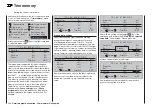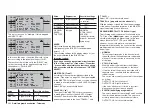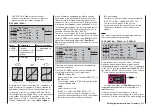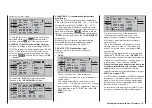
232
Detail program description - Telemetry
In addition, there are the relatively elaborate methods
of the of the individual adjustment using the options
"MODE", "F.S.Pos." and "DELAY". The description of
these variants begins with the "MODE" option further
below.
Value
Explanation
Possible
settings
OUTPUT
CH
Output channel
(servo connection
of the receiver)
1 … depending
on receiver
INPUT CH Input channel
(channel
coming from the
transmitter)
1 … 16 %
MODE
Fail-Safe mode
HOLD
FAIL SAFE
OFF
F.S.POS.
Fail-safe position
1000 … 2000 μs
DELAY
Reaction time
(delay)
0.25, 0.50, 0.75
and 1.00 s
FAIL
SAFE ALL
Save of the Fail-
safe
Positions of all
control channels
NO / SAVE
POSITION Display of the
saved Fail-safe
position
Between approx
1000 and 2000 μs
OUTPUT CH (servo connection)
In this line you select the respective OUTPUT CH
(servo connection of the receiver) to be set.
INPUT CH (selection of the input channel)
As already mentioned on page 228, the 16 control
functions of the
mc-20
HoTT transmitter can
be arbitrarily distributed to multiple receivers, if
necessary, or even assigned to multiple receiver
outputs with the same control function. For example,
this might be used in order to be able to control two
servers for each aileron fl ap or an oversize rudder
with linked servos instead of an individual servo.
Distribution to multiple HoTT receivers, in turn, offers
the advantage of not having to use a long servo
cable, e.g. for large models. In this case, bear in
mind that only the receiver selected in the line "TEL.
EMPF." through the »
Telemetry
« menu can be
addressed!
The 16 control channels (INPUT CH) of the
mc-20
HoTT can be appropriately managed through so-
called " Channel Mapping" (channel assignment)
whereby a different control channel is assigned to the
servo connection selected in the OUTPUT CH line for
the receiver in the INPUT CH line. BUT CAUTION: If,
for example, "2AIL" is specifi ed in the transmitter on
the "Aileron/camber fl aps" line of the »
Base setup,
model
« menu then
control function 2
(
Aileron)
will
already be assigned in the transmitter to
control
channels 2 and 5 for distribution to the left and right
ailerons.
The receiver's corresponding
INPUT CH
,
which must also be mapped, would be the channels
02 and 05 in this case; see the following example.
Examples:
You would like to control each aileron of a large
•
model with two or more servos.
You would like to control each aileron of a large
•
model with two or more servos.
Assign one of the two standard aileron
control channels 2 or 5 as INPUT CH to the
corresponding OUTPUT CH (servo connections)
depending on the left or right bearing surface.
You would like to control the rudder of a large
•
model with two or more servos.
Assign the same INPUT CH (control channel)
to the corresponding OUTPUT CH (servo
connections). In this case, this is the standard
rudder channel 4.
MODE
The settings of the options "MODE", "F.S.Pos." and
"DELAY" determine the behavior of the receiver in the
event of a failure in the transmission from transmitter
to receiver.
The setting programmed under "MODE" is
always
based on the channel set in the OUTPUT CH line.
The factory setting for all servos is "HOLD".
For each selected OUTPUT CH (servo connection of
the receiver) you can choose between:
FAI(L) SAFE
•
With this selection, in the event of a failure the
corresponding servo moves to the position shown
in the "POSITION" line for the remainder of the
failure until the "Delay time" set in the "DELAY"
line has lapsed.
HOLD
•
With a setting of "HOLD", in the event of a failure
the servo maintains the last correctly received
servo position for the duration of the failure.
OFF
•
With a setting of "OFF", in the event of a failure
the receiver discontinues the retransmission
of (temporarily stored) control impulses for the
respective servo output for the duration of the
failure. In other words, the receiver switches the
impulse line "off".
BUT CAUTION: Analog servos and even some
digital servos no longer put up any resistance
against the previous control pressure during the
failure of the control impulse and are more or less
pushed out of their position as a result.
F.S.POS. (Fail-safe position)
For each OUTPUT CH (receiver servo connection),
set the position the given servo should assume in
"FAI(L) SAFE" mode, i.e. in the event of a failure, via
Summary of Contents for 32032
Page 1: ...33020 mc 20HoTT 2 en Programming Manual o Pro Pro mc 20 mc 20...
Page 15: ...15 For your notes...
Page 21: ......
Page 27: ...27 For your notes...
Page 41: ...41 For your notes...
Page 53: ...53 For your notes...
Page 59: ...59 For your notes...
Page 63: ...63 For your notes...
Page 93: ...93 For your notes...
Page 97: ...97 For your notes...
Page 141: ...141 How is a ight phase programmed...
Page 145: ...145 For your notes...
Page 155: ...155 For your notes...
Page 175: ...175 For your notes...
Page 203: ...203 For your notes...
Page 219: ...219 For your notes...
Page 253: ...253 For your notes...
Page 283: ...283 For your notes...
Page 321: ...321 For your notes...
Page 322: ...322 For your notes...
Page 323: ...323 For your notes...
















































